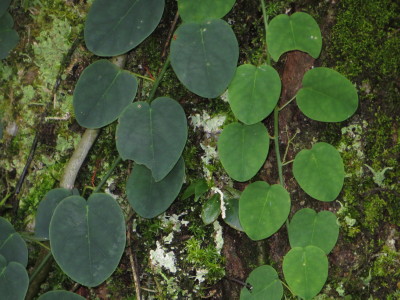Passiflora arbelaezii
Passiflora arbelaezii seems to be increasing its presence at La Selva. It was extremely rare in the 1970's when I worked with the Heliconius community; in fact I didn't recognise it as a Passiflora (because of the branched tendrils) until late in my study. Owing to the unusual branched tendrils and flower placement, P. arbelaezii is placed in a special gubgenus of Passiflora: Deidamioides section Tryphostemmatoides. However, ecologically it seems somewhat similar to P. biflora so I have grouped it with the other Decaloba species. Range: narrowly found in the La Selva area over to Tortuguero, and also found in Nicaragua and Western Colombia. In wet forest, forest edges and second growth, usually growing on tree trunks. Zero to 150 meters elevation.
The flowers have bright orange pollen.
This is a shade-loving species that often climbs tree trunks, and is seldom if ever used as a host plant by Heliconius, even though its foliage is palatable to H. cydno. However, the heliconiine Dryas iulia does lay her eggs on plants growing in sunny disturbed areas where the butterfly can find them; in some cases nearly defoliating the plant with repeated ovipositions. Supposedly H. hecalesia lays eggs on this species, though I have not seen this.
Cyanide testing reveals that this is a consistently potent plant, whose leaves contain between 2 and 12 μM HCN/g plant tissue. I have not found a description of the cyanogenic glycosides found in this plant, but based on ecological similarity to P. biflora, it may contain Passibiflorin and Epipassibiflorin or some other compounds found in Decaloba species. See Appendix 2, charts A1, A2 and A3 for cyanogenesis measurements.
The only flea beetle I have seen on this species was a single Red-black Flea Beetle (Monomacra chontalensis) which ate only a small portion of one leaf. Normally, these plants show no signs of flea beetle damage, even though nearby P. auriculata and P. biflora are occupied by Monomacra violacea, Parchicola DF2, and Ptocadica bifasciata.
This species occasionally develops egg-mimetic structures which are modified flower buds at the tips of the lateral tendril branches. They are remarkably similar-looking to Heliconiine eggs, and are the correct size. The tendril tips also grow strong adhesive pads allowing them to cling strongly to a smooth surface such as a tree trunk. It is interesting that the evolution of a single innovation, branched tendrils, may have facilitated at least two remarkable adaptations: egg mimic structures and the growth habit of climbing tree trunks. My observations suggest that upwardly climbing branches retain the tendril habit, including the possibility of forming adhesive pads, but that larger drooping branches will switch to the egg-mimetic form on some but not all tendril tips. The drooping branches then produce flower buds. Bohn et. al. (2015) have published an anatomical study of adhesive pads in the closely related Passiflora discophora. See also series of photos showing pad development.

The round leaves are often seen plastered against tree trunks. At the right of center you can see the tiny pads adhering to the tree trunk.

